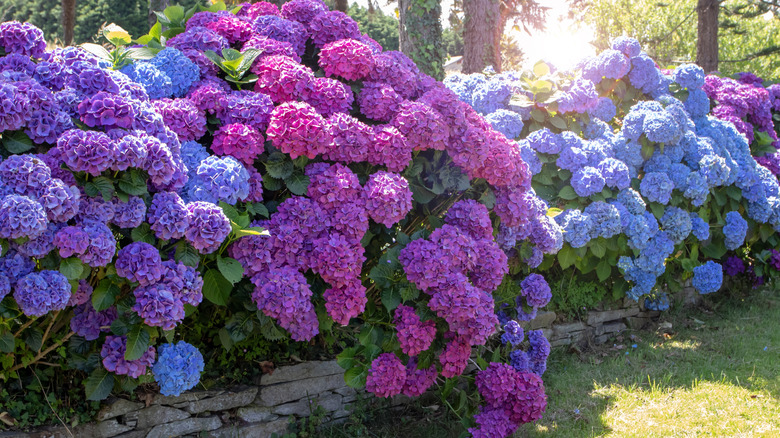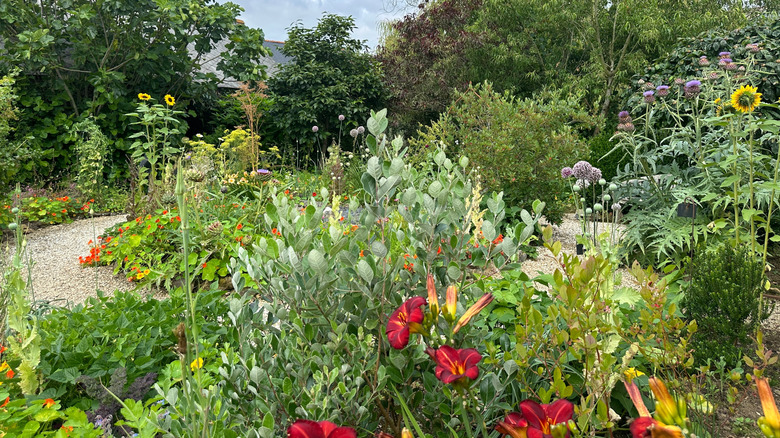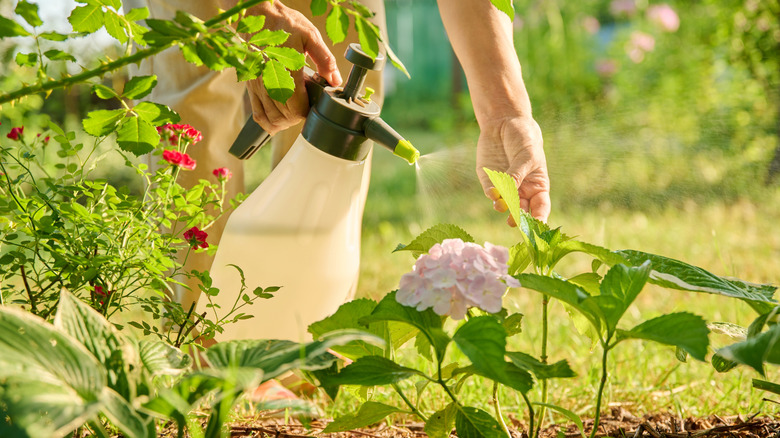Common Hydrangea Companion Planting Mistakes To Avoid
Hydrangeas can add gorgeous bursts of color to your garden, and companion planting is an excellent strategy to ensure they grow healthy and strong — but only if you do it right. Mistakes can be common when choosing what to grow nearby. It's not only about creating a thriving, beautiful garden, it's also about making specific choices regarding which plants are most beneficial to one another. Without careful consideration of what you plant with your hydrangeas, you may find yourself dealing with weak and struggling blooms.
It's crucial to remember that "hydrangeas" can refer to several different varieties, each with different growing needs and specifications. Good companion plants for hydrangeas typically include begonias, hostas, daylilies, and azaleas, among others. You'll get the best results by choosing options that thrive under conditions similar to your hydrangeas, thereby creating a flourishing garden community instead of an environment marked by constant competition among your plants.
Smart companion planting can offer gardeners a host of benefits: promoting natural pest control, increasing garden diversity, and improving soil health. This practice is also a handy space saver, especially when working within a smaller garden. Whether you're planting oakleaf hydrangea (Hydrangea quercifolia), panicle hydrangea (Hydrangea paniculata), or bigleaf hydrangea (hydrangea macrophylla), here are the crucial mistakes you should avoid.
Mixing sunlight needs and planting too close together
Look carefully at light needs before planting anything with your hydrangea. While some plants love the sun, most hydrangeas prefer to keep it on the shady side. For example, if you have a vision of an array of sunflowers mixed with your hydrangeas, you might want to change your mind — especially if you live in a hotter area. Sunflowers demand a minimum of six to eight hours of full sun, but not every hydrangea variety can tolerate that. Even the panicle hydrangea, known for thriving in bright sunlight, could struggle if blocked by a tall sunflower.
Overcrowding is another garden planting mistake when adding companion plants to your hydrangeas. Flowers need good air circulation, so spacing them properly is essential for ensuring equal access to light, water, and air. Introducing companion plants that encroach on hydrangeas can also attract pests and promote disease. When plants are too close together, the air around them can quickly grow humid and stale — potentially causing powdery mildew or other infections. Plus, this can make your flowers struggle for light and nutrients, often resulting in stalled growth. Before planting, consider each plant's spreading or growing style to limit the possibility of overcrowding. For instance, hostas have a compatible growing habit with hydrangeas, so they won't vie for resources. Overall, the best practice involve planting flowers or plants with complementary relationships within two to three rows of each other.
Choosing plants with different water, soil, and pest needs
Combining plants with drastically different water and soil needs often leads to unhappy and weak plants. This imbalance means that some plants will end up with too much water, while others won't have enough and might eventually dry out. For a thriving garden, ensure you match plants with similar watering and soil preferences. For instance, when watering your hydrangeas, remember that they need regularly moist, but not soggy soil, which can clash with, say, a rose bush that prefers deep watering in less frequent sessions, drying out in-between in order to retrieve nutrients and moisture from the soil.
Plants also vary in their soil preferences. Since soil and moisture needs go tend to go hand-in-hand, neglecting these aspects can be a costly mistake. Your hydrangeas will typically want well-draining soil with organic matter, whereas lavender and rosemary both prefer leaner soil. Some plants, like sunflowers, are even allelopathic, which means they leach toxins into their soil that suppresses the growth of neighboring plants.
Another consideration is pest control. Some of the hydrangea family's main pests include aphids, Japanese beetles, and two-spotted spider mites. Meanwhile, zinnias attract aphids and spider mites. On the other hand, adding a plant like a daylily could be a better choice, unless you already have a two-spotted spider mites problem, in which case a daylily can make it worse.


